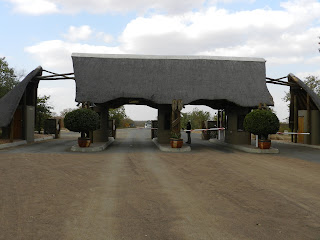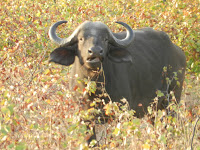On the way to Kruger we stopped to see the biggest BAOBAB Tree on the earth. This is a very unique "upside down" tree. It is only found in Africa and sparsely at that. This particular tree has been carbon dated to be +/- 6000 years old. It is 147 feet around the base of this tree. Legend has it that "the gods" were so shocked at its bitter fruit, that they planted it upside down forever more. At this tourist site, was discovered there was a door- size opening. Upon further investigation, upon entering, inside was discovered signs of tribal writings and signs that others had used it as a refuge from the elements of Africa. Today they have a small bar inside since it has been turned into one of Africa's tourist attractions. The pictures tell a thousand words.



We left there and headed directly to Kruger Park. We arrived at the Kruger Park Phalaborwa Gate at about 3 PM which is almost to the northern end of the park. From here we needed to travel 40km to where we were staying the night in the park itself. We needed to be checked in at our lodging, have our dinner (a Brai or BBQ), all before 7:15 PM before heading out for a night game drive.
Here we are at the entrance sign.
The entrance gate into the park
We no sooner entered the park when we started seeing game. Between the gate and our lodging here is some of what we saw.


After stopping at every game sighting we discovered that our time was running out and we still needed to check in for the night. We saw the Hyaena's just as we were approaching our digs.
Monday Evening at about 5:30 PM we finally arrived at the Letaba Bush Camp and checked in. We got our keys, located our Rondeval or hut, put away our luggage and started dinner. Our accommodation were very nice as you can see. The kitchen is the outdoor patio.



We had to light up three charcoal grills to cook our delicious dinner provided by the Evans', which consisted of steak, boravores (African sausage) mealie pap (thick corn meal), coleslaw and baked beans. We finished by 7 PM in time to meet the truck for our night game drive. Not much was seen in the two hours we were out, only a few small furry animals such as the Genet, the rare Springhare and several Mongoose.
Tuesday morning we were up at 6 AM so as to be on the game trail at sunlight. We drove all over the park taking advantage of as much ground as we had time. It was our plan to stop at 8:30 AM for breakfast. But with all the driving, and the game sightings we underestimated the driving time so breakfast became brunch at about 11:30AM. All along the road we were seeing so much game which slowed us down. We needed to exit the game park by 6 PM so we needed to watch our time.
Here is some of what we saw during our morning drive.

Hippos, Zebras, Lion; you have to look carefully for the lion. She is in the upper middle of the lower picture. This was taken just before sundown in a shaded grassy area. It shows how they can hide themselves in the landscape.






Due to a "crazy, anxious, van-in-the-sand" episode, we finally reached The Paul Kruger Gate to leave the park at about 5:45 PM only to discover that it closed at 5:30 PM. After describing our misunderstanding of the closing time the guard let us through. We headed out for the Hamilton Parks Guest Retreat located just outside Hazeyview about 68km from the Paul Kruger Gate. It seemed like we drove forever trying to find this place. Finally we located it after calling ahead for directions. It was dark when we got there and had a decline straight down a 3 km mountain road - we had no idea what we were in for.
Finally we got there and to our surprise this was a wonderful facility surrounded by 400 acres of indigenous bush land, teaming with bird life, flora and fauna. It was not until we got up at 7 AM for breakfast the next morning that we discovered the beauty of the place; the rooms were very nice and suitable - nobody was disappointed as you can see from the pictures.




Ian &Jaci Evans, us, Browns and Mincks.
We were up at 7 AM for breakfast and on our way to Swaziland to meet the other van of missionaries from Jo'burg. Traveling from Hazeyview through Nelspruit to Barberton were hills after hills, miles after miles of tree plantations. Hundreds of years ago somebody transplanted pole pine and gum trees from Austria and created these plantations. It takes 30 years for a tree to reach maturity so you saw every level of growth throughout the plantations. It was quite impressive to say the least! These are used in the many mines in So. Africa.
We got a little behind as we were to meet our friends at the glass factory at 11 AM but did not make it there until just after 12 Noon. After making it through the Josephsdal Bulembu Border Post we finally hooked up with the other missionaries and toured the glass factory. Since it was Jenee's birthday today she picked out a very beautiful necklace as her gift from me. Oh how sweet of me to remember - Yeah - I entirely forgot until she reminded me later that night! From there we set out to see other sights that Elder Evans had scheduled.
We set out for Mbabane ("mmm-ba-banny")to visit a small gift shop area where we were told we would find a silver shop that had good prices, so everybody wanted to get some silver trinkets or jewelry. Some took advantage of it while others did not. Jenee and I weren't into the silver thing so we just walked around, sat and waited for the others.
From there we traveled to Manzini and cities in-between, making our way to the only native craft market in Swaziland. This market consisted of 89 outdoor stalls. Three were run by members of the church so we visited with them and purchased sundry items to 'make their day'.
After the market it was time to get some dinner and locate our accommodations for the night. We went to the only strip-mall in the city which had a variety of restaurants. Some of us chose Chinese, some chose Spurs for Steak and one couple chose pizza. We met up at about 6:30 PM and headed for the accommodation that Elder Evans had arranged for us. Once again we were not disappointed in his selection. Each beautiful room had a different flower/color theme.


After being served a delicious breakfast we set out to see a number of sights remaining on our list.
Today was Thursday, the day when all the local citizens gather at the city center plaza to sell their wares. This was a remarkable sight to see, people sitting round showing off their goods in every fashion. Prices were remarkably cheap so everybody took advantage and purchased something they desired. Pretty much the local version of a flea market.


From here we went to the only Botanical Garden in Swaziland - and to our amazement it was something to behold. It is called "Summerfield Botanical Gardens & Exclusive Resort." From the pictures you will see why it is named such. This place was built by a wealthy American who visited Swaziland on business (mining) and fell in love with the country. Not discovering any botanical gardens in Swaziland he decided to spend millions of his own dollars to create this facility.
With waterfalls, cascades and lush lakeside gardens one finds an oasis of tranquility while dining at the Lakeside Pavilion & Private Gazebos or in the exquisite and Private dinning room and restaurant. Le' Caille, Swazi-style!
Take a look for yourself!


Our next and final stop for the day was at the "GONE RURAL" basket making facility. This is a company that makes all kinds of grass-woven items from baskets, plates, rugs, glass coasters - you name it - in all colors and varieties.
Gone Rural empowers 750 rural women by providing them with a home-based income and skills training. The local women (either divorced, widowed, or abandoned by husbands) hand-make these products from the local Luindzi grass which they harvest from the mountain regions. They cut the grass and dry it prior to Gone Rural picking it up for dying. At the same time Gone Rural picks up the grass they deliver the dyed grasses in all colors along with the designs and items they want made by the women to fill their orders. They ship these items all over the world to African Retail Shops.
This project also provides to communities mobile health clinics, school fees scholarships for their children, HIV/AIDS educations and access to clean drinking water. A remarkable organization helping the local Swaziland citizens.
Swaziland is a beautiful place with its own culture. The country still has a tribal chief and a Queen Mother along with an elected Prime Minister over governmental affairs. The countryside is typically Africa with the land covered with sugar cane fields as far as the eye can see. Sugar Cane is one of their major agriculture exports along with bananas. We also saw fields of sorghum plants as well.
Typical housing for natives in Swaziland
Umbrella Thorn Tree

Countryside in Swaziland
Banana Plantation
Sugar Cane Field
This was the end of our sight-seeing since we needed to fill the vans with gas, get a bite to eat and start home for Johannesburg. We arrived home at about 10:30 PM after four fun-filled days of activities and adventures in both Kruger National Game Park and Swaziland. A giant THANKS to the Evans!!!




























